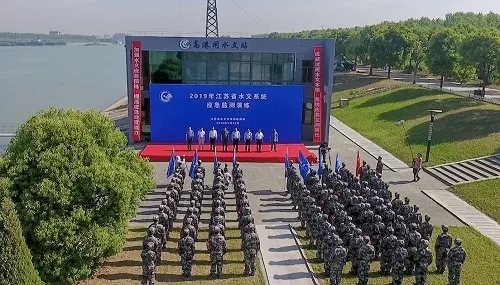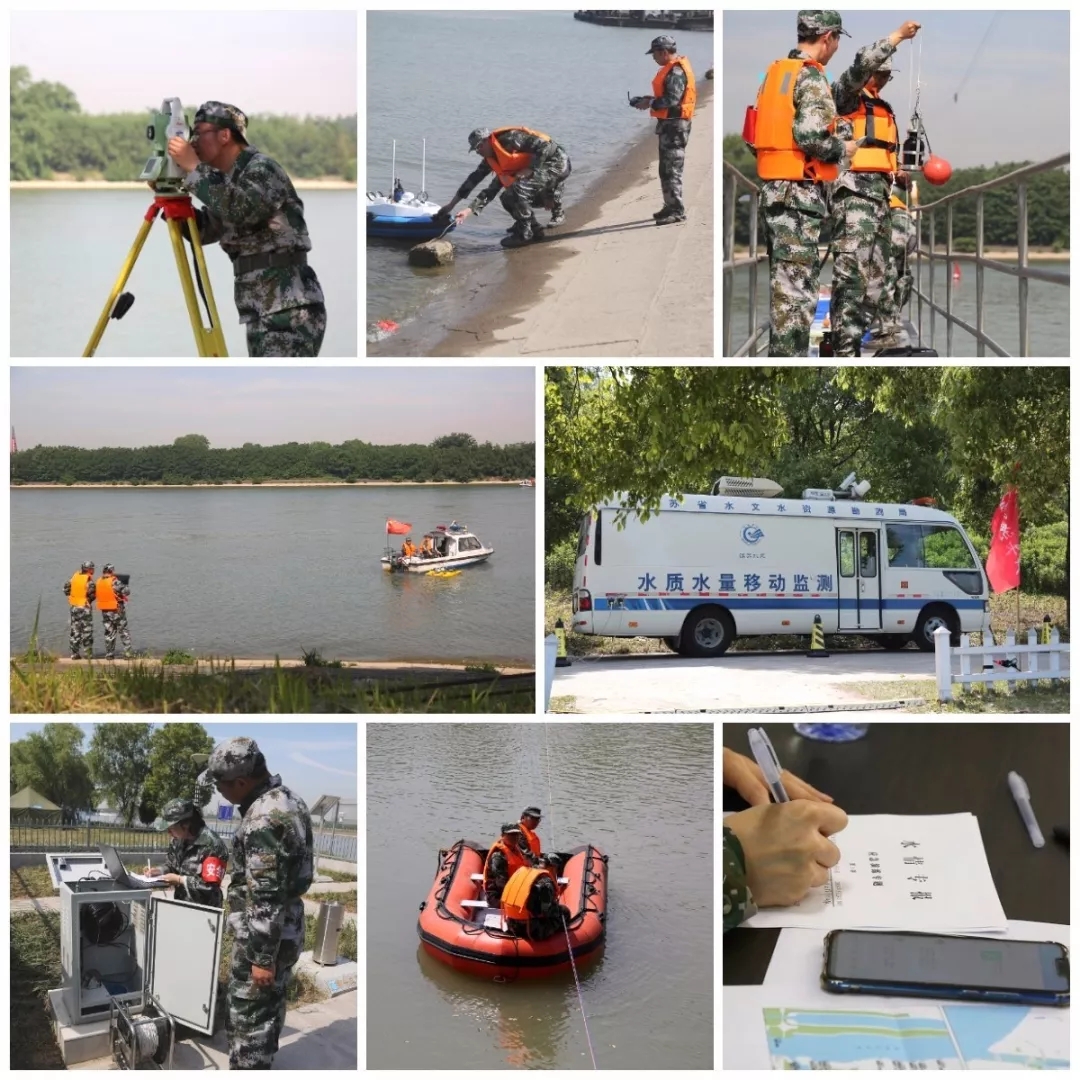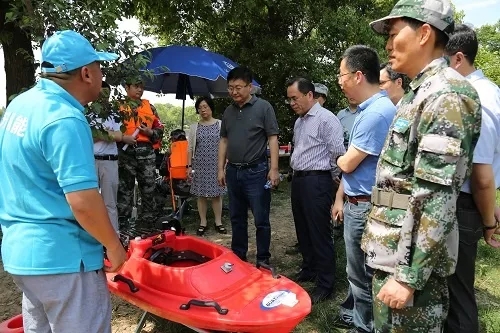On May 24, the Provincial Hydrological emergency monitoring drill was successfully completed in Gaogang Water Conservancy Complex of Taizhou River Diversion Project in 2019. Zhang Jinsong, deputy director of provincial water resources department, visited the drill site. The provincial flood and drought disaster prevention and dispatch command center, provincial water resources service center, provincial Taizhou River Diversion Administration Office, provincial flood control and drought prevention and rescue center, Taizhou Water Resources Bureau and Linzhi Hydrological Branch of Tibet Autonomous Region were responsible for comrades'guidance and observation. About 120 members of the hydrological emergency monitoring team from the Provincial Hydrological bureau, the relevant water conservancy project management department of the Department and the hydrological sub-bureaus of the Bureau participated in the drill. It is the first time in the hydrological history of Jiangsu that the scale of the drill, the number of participants and the set of subjects are all large.


This exercise assumes that the Lixia River area in the Huaihe River Basin is suffering from drought. The Gaogang Water Conservancy Junction Pumping Station will fully divert water and supply water to the Lixia River area to meet the people's water demand. During the collision accident of dangerous chemicals vessels, it is necessary to monitor the water quality closely and pay attention to the change of water quality. In order to ensure the safety of water supply in river basins and regions, the provincial flood control and drought control command department urgently requests the Provincial Hydrological emergency monitoring team to rush to the scene and carry out hydrological emergency monitoring in the waters related to the river diversion in Taizhou, so as to provide timely, comprehensive and reliable basic information for the decision-making and deployment of relevant departments.
At 8:30 a.m. on the 24th, emergency drill teams rushed to the scene in time. Each department carried out orderly monitoring location survey, monitoring vehicle follow-up, instrument installation and hoisting, data collection and calculation, and successfully completed topographic survey, level water level monitoring, section measurement, flow test, water quality monitoring, water emergency self-monitoring. There are 18 exercise subjects in dynamic monitoring.
The drill used many new instruments and equipment, such as water and rain emergency monitoring station, remote control ship, unmanned aerial vehicle, radar side scan, video surveillance and so on. It adopted many kinds of flow measurement methods, such as on-bridge flow measurement, radar sweep flow measurement, buoy flow measurement, ADCP remote control ship flow measurement, unmanned aerial vehicle radar flow measurement and so on. Close to actual combat. The whole drilling process is tense and orderly. Emergency monitoring team members cooperate with each other, react quickly, measure and report accurately and timely. On-site command and drill personnel cooperate tacitly and achieve good results.

Zhang Jinsong affirmed the results of the emergency monitoring. He believed that the hydrological team was well prepared in the early stage, well organized in the process and skilled in the team, which proved the cohesion and fighting effectiveness of the hydrological team. Zhang Jinsong requests the hydrological system of the whole province to make every effort in this year's flood season to ensure that there is no leakage in monitoring, no error in prediction, no blind area in early warning and no omission in service, so as to fully serve the flood and drought disaster prevention work.
Xin Huarong requests that, first, we should make painstaking efforts to improve the monitoring level. It is necessary to further improve the level of technical equipment for emergency monitoring, and make every effort to improve the speed and efficiency of emergency response to water emergencies, so as to ensure the advance, accurate measurement and timely reporting. Second, we should achieve results in the word "Guan" and effectively optimize the working mechanism. We should further improve the emergency monitoring system, revise and improve the emergency plan, speed up the formulation of operational standards and procedures for hydrological monitoring, implement the detailed management of all links, strengthen training and drilling, and ensure safe flood season. Third, we should make every effort in the word "prevention" and earnestly do a good job in forecasting and early warning. Precise monitoring, accurate forecasting, accurate early warning and meticulous service should be achieved. Continuously improve the ability of water regime in-depth analysis, evaluation and prediction, early warning and prediction, accelerate the refinement, diversification and product of the results, and provide reliable support for the province's safe flood season and accurate dispatch.

On May 22, in order to lay a solid foundation for the drill, the Provincial Hydrological Bureau held an emergency monitoring training course, inviting experts from the Hydrological Bureau of the Long Committee, the Hydrological Bureau of the Huang Committee, the hydrological downstream Bureau of the Long Committee, the Linzhi Hydrological Branch of the Tibet Autonomous Region and the Taizhou Armed Police Branch to take emergency monitoring examples to discuss the methods of hydrological emergency monitoring, emergency operation command and fixed AD. Lectures were conducted on the research of CP measurement technology, and on-site demonstrations and questions were answered.
On May 23, the Provincial Hydrological Bureau held a contest for disassembling and assembling flow meters and rain gauges. Twelve "post-90s" hydrological youth from the Provincial Hydrological Bureau, Hongze Lake, Huaishu New River and the General Canal Management Office, Nanjing, Wuxi, Changzhou, Nantong, Huaian, Taizhou and Suqian Hydrological Branches participated in the skill competition. The competition has excavated outstanding technical talents of hydrological system, and stimulated the enthusiasm of young talents of the whole system to study business and practice skills.
In the coming flood season, the provincial hydrological system will continue to make unswerving preparations for "flood prevention, drought relief and emergency rescue" starting from the training and drilling of emergency monitoring, raise awareness, re-implement responsibilities, take solid measures, re-strengthen and resolutely shoulder the heavy burden of flood and drought disaster prevention, with a high degree of responsibility. Sense of mission and sense of mission treat the work of monitoring and forecasting, when summoned, it will be able to fight, war will be able to win, in order to win this year's flood control and drought prevention work in an all-round victory to contribute hydrological strength.